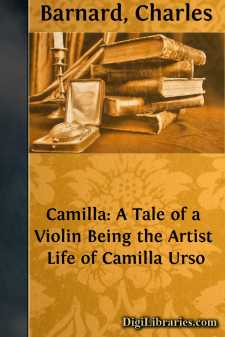Categories
- Antiques & Collectibles 13
- Architecture 36
- Art 48
- Bibles 22
- Biography & Autobiography 813
- Body, Mind & Spirit 142
- Business & Economics 28
- Children's Books 14
- Children's Fiction 11
- Computers 4
- Cooking 94
- Crafts & Hobbies 4
- Drama 346
- Education 46
- Family & Relationships 57
- Fiction 11829
- Games 19
- Gardening 17
- Health & Fitness 34
- History 1377
- House & Home 1
- Humor 147
- Juvenile Fiction 1873
- Juvenile Nonfiction 202
- Language Arts & Disciplines 88
- Law 16
- Literary Collections 686
- Literary Criticism 179
- Mathematics 13
- Medical 41
- Music 40
- Nature 179
- Non-Classifiable 1768
- Performing Arts 7
- Periodicals 1453
- Philosophy 64
- Photography 2
- Poetry 896
- Political Science 203
- Psychology 42
- Reference 154
- Religion 513
- Science 126
- Self-Help 84
- Social Science 81
- Sports & Recreation 34
- Study Aids 3
- Technology & Engineering 59
- Transportation 23
- Travel 463
- True Crime 29
Camilla: A Tale of a Violin Being the Artist Life of Camilla Urso
by: Charles Barnard
Categories:
Description:
Excerpt
CHAPTER I.
BEFORE DAWN.
About thirty miles from the sea, on the River Loire, in France, stands the quaint, sleepy old town of Nantes. The Erdre and the Sevre, two smaller streams unite with the Loire just here and the town is spread out in an irregular fashion over the islands, the little capes between the rivers, and the hills that stand round about. The old part of the town is on the hill-side and occupies the two islands called Freydean and Gloriette, the more modern city has spread over the surrounding country among the groves of chestnut, and the vineyards that fill every available spot where the grapes can get a good look at the sun all through the long sunny days.
The river runs swift and bright through the town and flashes under the handsome bridges with their long rows of stone arches. In the river are boats, ships, and steamers, for the good people there spend much of their time in commerce and in catching and curing the silver-white pilchards that swim in such great schools in the neighboring sea.
The broad quays that skirt the river are planted with trees, making a most delightful walk, and near the eastern end of the town one of the quays ends at what remains of an old chateau or palace. The houses are mostly of stone, with slated roofs. There are some fine stores in the Place Royal that are quite as grand as those in Paris. There are also some old, old churches black with age, dim and vast inside, with statuary on the outer walls, and splendid gothic towers that seem to blossom all over with stone flowers as they climb so far up into the sky above the quaint old town.
Round about the town are gardens and summer houses, pleasant walks and drives, vineyards, groves and all the things that go to make a charming rural scene.
In the Place Graslin is a fine theatre and a handsome Town Hall. Of these buildings more presently when we come to see what happened within them.
In this old French town in June 1846 there lived a very little girl just four years old. Her home was on the first floor of a small house on a narrow street not far from the Place de la Monnaie, an open square that led into one of the principal streets known as the Rue Voltaire. The house was built in the usual French fashion with a large arch-way under the house that led into a court-yard in the centre. The front door opened into the shady arch-way, and the window balconies were filled with flowering plants in pots.
Her name was Camilla. Her father Monsieur Salvatore Urso played the flute in the orchestra at the theatre, or opera house, and on Sundays played the organ at the Church of the Holy Cross that stood facing a little square not far from the river.
Her mother Madame Emelie Urso was a young and very handsome woman, and a fine singer. She also helped her husband in his music lessons. She was born in Lisbon in Portugal, but as she had come to France when quite young, she had forgotten her mother tongue and now spoke French and Italian. This last may have been owing to the fact that her husband was from Palermo, Sicily. With Camilla’s parents lived her mother’s sister, Caroline, whom we shall know as aunt Caroline. This made the Urso household.
Both of Camilla’s parents were young and she was their oldest child and only daughter. There was at this time a baby brother and later there were three more brothers. The first four years of the little one’s life were passed in an uneventful manner, very much in the fashion of other children everywhere. When she was four years old she began to go to the theatre with her father. Every night she put her small hand in his and trotted off to the Place Graslin to sit with him in the orchestra among the violins and close beside her father’s flute....


